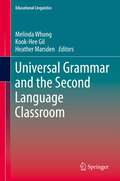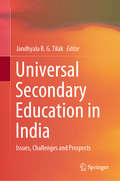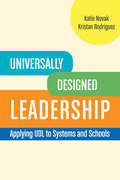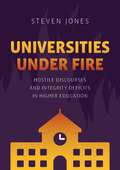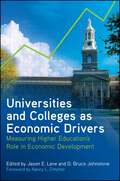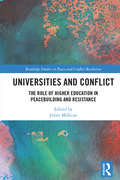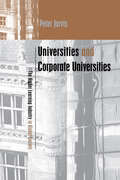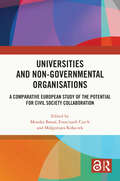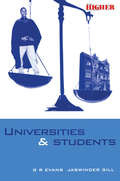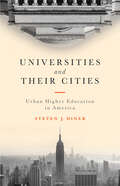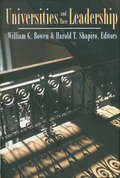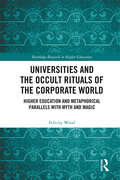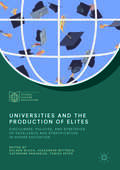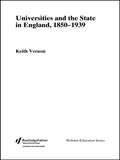- Table View
- List View
Universal Grammar and the Second Language Classroom
by Kook-Hee Gil Heather Marsden Melinda WhongThis book proposes that research into generative second language acquisition (GenSLA) can be applied to the language classroom. Assuming that Universal Grammar plays a role in second language development, it explores generalisations from GenSLA research. The book aims to build bridges between the fields of generative second language acquisition, applied linguistics, and language teaching; and it shows how GenSLA is poised to engage with researchers of second language learning outside the generative paradigm. Each chapter of Universal Grammar and the Second Language Classroom showcases ways in which GenSLA research can inform language pedagogy. Some chapters include classroom research that tests the effectiveness of teaching particular linguistic phenomena. Others review existing research findings, discussing how these findings are useful for language pedagogy. All chapters show how generative linguistics can enhance teachers' expertise in language and second language development. "This groundbreaking volume ably takes on the gap that currently exists between generative linguistic theory in second language acquisition (GenSLA) and second language pedagogy, by gathering chapters from GenSLA researchers who are interested in the relevance and potential application of their research to second/foreign language teaching. It offers a welcome and thought-provoking contribution to any discussion of the relation between linguistic theory and practice. I recommend it not only for language teachers interested in deepening their understanding of the formal properties of the languages they teach, but also for linguists interested in following up on more practical consequences of the fruits of their theoretical and empirical research." Donna Lardiere, Georgetown University, Washington DC, USA
Universal Secondary Education in India: Issues, Challenges and Prospects
by Jandhyala B. G. TilakThis book offers a cutting-edge contribution on the importance of secondary education and assesses the strengths and weaknesses of its growth in India. Secondary education, long neglected, faces countless challenges and will require tremendous financial resources, millions of additional trained teachers, and vast infrastructure in terms of buildings, laboratories, libraries, ICT facilities, etc. The book examines these critical issues, with particular reference to the situation in India. It analyses the status quo of secondary education and discusses the strategies and approaches needed in order to universalize it. Including 20 chapters authored by eminent scholars in the field and from across the country, this book gathers the outcomes of a seminar organized by the Council for Social Development on Universalization of Secondary Education. The target audience includes policymakers, practitioners, administrators, education planners, researchers, teachers, and teacher educators with an interest in the future of secondary education.
Universally Designed Leadership: Applying UDL to Systems and Schools
by Katie Novak Kristan RodriguezThe new Every Student Succeeds Act governing K-12 education in the United States defines and endorses Universal Design for Learning (UDL) as a framework to help achieve greater opportunity and academic achievement for all learners, including those with disabilities, English learners, and "gifted and talented" students. In this book, Novak and Rodriguez, veteran school administrators, provide school leaders and educators with a guidebook for putting the UDL framework into practice. They show how to guide district and school staff in discussions around student data and use the UDL guidelines to shape curriculum decisions. This is a must-read for any education leader who wants to create more equitable, inclusive, and effective learning environments.
Universidad 2.0
by Rafael Rangel SostmanEl papel de las universidades en nuestra sociedad y su futuro en el desarrollo de la humanidadUna plataforma de reflexión para quienes están al frente de las instituciones.Ante las profundas transformaciones de nuestra sociedad, caracterizada, entre otros aspectos, por vivir un proceso de globalización en medio de la revolución digital, y por los desafíos que para el desarrollo plantea la nueva economía del conocimiento, la Universidad se ve obligada a redefinir la misión que debe desempeñar en la actualidad.Universidad 2.0 es la propuesta de un autor con la experiencia de ser rector durante 27 años de un importante sistema universitario. Según su autor, la misión de la universidad es convertirse en el motor del desarrollo económico, educativo y social; la generación del conocimiento necesario para resolver los grandes retos de desarrollo de nuestra realidad; el involucramiento social; el impulso de la equidad; así como el incremento de las oportunidades a fin de disminuir las brechas socioeconómicas.De tal manera, Universidad 2.0 es una plataforma de reflexión para quienes están al frente de las instituciones universitarias en nuestros países, así como de todos aquellos interesados en el desarrollo equilibrado de la humanidad.
Universities Under Fire: Hostile Discourses and Integrity Deficits in Higher Education (Palgrave Critical University Studies)
by Steven JonesThis book explores the ways in which the contemporary university is talked about, and talks about itself. Focusing on English higher education, Jones documents how an under-confident sector internalised the language and logic of government policy, and individual institutions then set about normalising competition and gaming short-term advantage at the expense of collectively serving a common good. A flawed marketisation project was attended and sustained by hostile discourses, with purportedly woke universities becoming a soft target for right-leaning politicians and media commentators, and campuses reluctant battlefields for manufactured culture wars. Within this context, integrity deficits soon arose: universities bragged about diversity and social responsibility without commensurate action; global ambitions went unmatched by local accountability; senior management grew more distant and self-rewarding as contractual precarity increased for frontline staff. Jones does not call for a return to any golden age of academic self-rule. Rather, he warns that without self-assured new stories, firmly underpinned by more transparent and moral forms of governance, universities risk further compromising their standing as trusted public institutions at the very moment they are needed most.
Universities and Civilizations: Worldwide Academic Competition and Geopolitics
by Franck LeprevostSince the publication of the first Shanghai ranking in 2003, the international rankings of universities have become evermore important. This book examines the evolution of higher education systems and the role of universities in contemporary societies, which are marked by increased competition and tensions. Investigating whether the dynamism of large universities is an accurate indicator of the intellectual life of their civilizations, Universities and Civilizations systematically analyzes the evolution of universities in several main rankings, from their creation until now. This analysis shows the rise of universities in China and parts of Europe, the decline of American and Japanese universities and the scant presence of universities in Russia, India, Africa and Latin America. This book suggests an overhaul of traditional models of academic cooperation and exchange in an era of growing international tensions and a time when people and knowledge are increasingly mobile.
Universities and Colleges as Economic Drivers: Measuring Higher Education's Role in Economic Development (SUNY series, Critical Issues in Higher Education)
by Jason E. Lane D. Bruce JohnstoneLocal, state, and national economies are facing unprecedented levels of international competition. The current fiscal crisis has hampered the ability of many governments in the developed world to directly facilitate economic growth. At the same time, many governments in the developing world are investing significant new resources into local infrastructure and industry development initiatives. At the heart of the current economic transformation lie our colleges and universities. Through their roles in education, innovation, knowledge transfer, and community engagement, these institutions are working toward spurring economic growth and prosperity.This book brings together leading scholars from a variety of disciplines to assess how universities and colleges exert impact on economic growth. The contributors consider various methodologies, metrics, and data sources that may be used to gauge the performance of diverse higher education institutions in improving economic outcomes in the United States and around the world. Also presented are new typologies of economic development activities and related state policies that are designed to improve understanding of such initiatives and generate new energy and focus for an international community of scholars and practitioners working to formulate new models for how public universities and colleges may lead economic development in their states and communities while still performing their traditional educational functions.Universities and Colleges as Economic Drivers is meant to cultivate greater understanding among elected officials, business representatives, policymakers, and other concerned parties about the central roles universities and colleges play in national, state, and local economies.
Universities and Conflict: The Role of Higher Education in Peacebuilding and Resistance (Routledge Studies in Peace and Conflict Resolution)
by Juliet MillicanThis book uses a series of case studies to examine the roles played by universities during situations of conflict, peacebuilding and resistance. While a body of work dealing with the role of education in conflict does exist, this is almost entirely concerned with compulsory education and schooling. This book, in contrast, highlights and promotes the importance of higher education, and universities in particular, to situations of conflict, peacebuilding and resistance. Using case studies from Europe, Africa, Asia and the Middle East, this volume considers institutional responses, academic responses and student responses, illustrating these in chapters written by those who have had direct experience of these issues. Looking at a university’s tripartite functions (of research, teaching and service) in relation to the different phases or stages of conflict (pre conflict, violence, post conflict and peacebuilding), it draws together some of the key contributions a university might make to situations of instability, resistance and recovery. The book is organised in five sections that deal with conceptual issues, institutional responses, academic-led or discipline-specific responses, teaching or curriculum-led responses and student involvement. Aimed at those working in universities or concerned with conflict recovery and peacebuilding it highlights ways in which universities can be a valuable, if currently neglected, resource. This book will be of much interest to students of peace studies, conflict resolution, education studies and IR in general.
Universities and Corporate Universities: The Higher Learning Industry in Global Society
by Peter JarvisAn exploration of the world of higher education and higher learning, and its relationship to the corporate world and the global learning society. Peter Jarvis synthesizes developments in HE, training and corporate research and development in order to map the future of learning and training.
Universities and Engagement: International perspectives on higher education and lifelong learning
by John Field Bernhard Schmidt-Hertha Andrea WaxeneggerUniversities and Engagement is a timely and insightful book that examines what universities can contribute to their communities and economies through lifelong learning, a topic which is of increasing importance to Higher Education Institutions across the world. The book will offer an answer to the question ‘What can be understood by University Lifelong Learning today?’ by collating the work of specialists from across Europe and beyond who have first-hand experience in the field of university engagement through continuing education. With a diverse range of expertise from the UK, Ireland, Germany, Finland, Malta, Belgium, New Zealand, Austria and the USA, readers are guaranteed a varied and informative collection of perspectives on this important topic. Taken as a whole, the book provides a theoretical background for readers, drawing on recent research and practice examples from a variety of countries and institutional settings, as well as demonstrating a variety of conceptual approaches, confirming the diverse range of possible solutions. Key topics covered include: research into policy and practice; engaging with business and industry; engaging with communities; engaging with an ageing society; active citizenship and regional competitiveness. Developed in collaboration with the European University Continuing Education Network (EUCEN), Universities and Engagement is an invaluable contribution to research in the subject of lifelong learning. It will be of value to academics, practitioners and professionals with an interest in higher education and community management, and will be particularly suited to those interested in lifelong learning, adult education and community development.
Universities and Epistemic Justice in a Plural World: Knowing Better (Debating Higher Education: Philosophical Perspectives #12)
by Margaret MeredithThis book explains why universities, and academics within them, must engage with the diversity of knowledges and knowers that exist in the world. Through philosophical perspectives, theoretical frameworks and practical examples from around the world, the book searches for opportunities for renewal and inclusion in universities. It explains how higher education can better serve the purposes of social justice by re-evaluating the types of knowledge it promotes. Going beyond the identification and analysis of injustices in ways of knowing in academia, the book offers insights and examples of practices in teaching, research and work with the community which aim to move towards justice on an epistemic level. It argues that inclusion in the domain of knowledge can lead to the generation of knowledges and understandings that are more robust and better equipped to address the pressing needs of the plural worlds outside the university. Contributions are included from authors working in varied disciplinary and cultural contexts in universities, who describe and explicate their work towards identifying epistemic injustice and finding spaces to advance knowledge justice in theory and in practice. The book will be beneficial to academics and those with an interest in the role of universities in serving the public good.
Universities and Global Diversity: Preparing Educators for Tomorrow (Routledge Research in Education)
by Beverly Lindsay Wanda BlanchettThis volume seeks to critically examine the nexus between globalization and diversity as it affects the preparation of professional educators on several continents, taking into account the extensive changes in economic, sociopolitical, and cultural dynamics within nations and regions that have occurred in the last decade.
Universities and Globalization: To Market, To Market (Sociocultural, Political, and Historical Studies in Education)
by Ravinder Kaur SidhuUniversities and Globalization: To Market, To Market examines the operations of power and knowledge in international education under conditions of globalization, with a focus on the three biggest exporters of higher education--the United States, Australia, and the United Kingdom. An interdisciplinary approach based on the core social sciences is used to explore the power relations that shape global education networks. The role of nation-states in creating the conditions for education markets and the desire for a Westernized template of international education in the postcolonial world is discussed. The volume offers a sophisticated attempt to recast international education as a series of geopolitical and geoeconomic engagements that transcend simple supply and demand dynamics.Engaging with the theoretical debates about education and globalization, this book examines global cultural "flows" and boundary crossings, the cultural economy of education networks, and the possibilities for supra-territorial subjectivities. International education markets are examined from the perspectives of both first world producers and postcolonial consumers. By investigating how first world universities imagine and enact the global in their marketing practices, the expressions of cultural diversity valued by education markets, and the types of individual and institutional subjectivities merging from markets, Universities and Globalization: To Market, To Market offers students, faculty, administrators, marketing consultants, and others who work in the area a highly nuanced account of the global relations fostered by education markets. This original, critical examination of the forms and cultural politics of international education is a significant contribution to the field.
Universities and Non-Governmental Organisations: A Comparative European Study of the Potential for Civil Society Collaboration
by Monika Banaś Franciszek Czech Małgorzata KołaczekIn the opinion of the general public, universities and NGOs would be natural partners for effective collaboration in many fields. They are indeed, but mainly in theory. This book examines the reasons why this is the case and what possible models of cooperation and facilitated dialogue between institutions of higher education system and NGOs could transform this theoretically optimal union into practice. The authors start with Poland and analyse legal, cultural and socio-economic factors, which impact upon the current state of affairs. Subsequently they move on to consider cases from four other European countries: Portugal, Austria, Slovakia and the United Kingdom. Then they propose possible solutions, areas for further research and formulate recommendations for strengthening future cooperation between the two main types of actors which shape education and increase awareness in civil societies. Universities and Non-Governmental Organisations will appeal to scholars across the social sciences with interests in higher education and research, public discourse and civil society.
Universities and Regional Development: A Critical Assessment of Tensions and Contradictions (International Studies in Higher Education)
by Rómulo Pinheiro Paul Benneworth Glen JonesUniversities are under increasing pressure to help promote socio-economic growth in their local communities. However until now, no systematic, critical attention has been paid to the factors and mechanisms that currently make this process so daunting. In Universities and Regional Development, scholars from Europe, the Americas, Africa, and Asia critically address this knowledge gap, focusing on policy, organization, and the role of individual actors to uncover the challenges facing higher education institutions as they seek to engage with their regions. In a systematic and comparative manner, this book shows internal and external audiences why, how, and when the institutionalization of universities’ "third missions" should take place, and also: challenges conventional wisdom about the role of universities in society and the economy demonstrates how institutions in different nations and regions cope with local engagement combines the latest national, regional and local research with international perspectives integrates diverse conceptual and disciplinary frameworks Universities and Regional Development is a key resource for researchers and students of higher education and territorial development, educational policy makers, and university managers seeking to engage with the world beyond their university.
Universities and Students: A Guide to Rights, Responsibilities and Practical Remedies
by Evans, G.R. Gill, JaswinderLegal actions by students against universities are growing in number, and the issues such actions raise are becoming a major concern for both teaching and administrative staff. This handbook is designed to clarify the legal framework that binds the student with the university or college.
Universities and Sustainable Communities: Meeting the Goals of the Agenda 2030 (World Sustainability Series)
by Walter Leal Filho Fernanda Frankenberger Ubiratã TortatoThe book showcases examples of university engagement in community initiatives and reports on the results from research and from a variety of institutional projects and programmes. As a whole, the book illustrates how actors at the community (microlevel) and other levels (meso and macro) can make valuable and concrete contributions to the implementation of the Sustainable Development Goals (SDGs) and, more specifically, to achieving the objectives defined at the 2030 Agenda for Sustainable Development. It is one of the outcomes of the “Second World Symposium on Sustainability Science”, which was jointly organised by the Pontifícia Universidade Católica do Paraná (Brazil), the Research and Transfer Centre “Sustainable Development and Climate Change Management” and the “European School of Sustainability Science and Research” at Hamburg University of Applied Sciences (Germany), in cooperation with the Inter-University Sustainable Development Research Programme (IUSDRP).
Universities and Their Cities: Urban Higher Education in America
by Steven J. DinerThe first broad survey of the history of urban higher education in America.Today, a majority of American college students attend school in cities. But throughout the nineteenth and much of the twentieth centuries, urban colleges and universities faced deep hostility from writers, intellectuals, government officials, and educators who were concerned about the impact of cities, immigrants, and commuter students on college education. In Universities and Their Cities, Steven J. Diner explores the roots of American colleges’ traditional rural bias. Why were so many people, including professors, uncomfortable with nonresident students? How were the missions and activities of urban universities influenced by their cities? And how, improbably, did much-maligned urban universities go on to profoundly shape contemporary higher education across the nation?Surveying American higher education from the early nineteenth century to the present, Diner examines the various ways in which universities responded to the challenges offered by cities. In the years before World War II, municipal institutions struggled to "build character" in working class and immigrant students. In the postwar era, universities in cities grappled with massive expansion in enrollment, issues of racial equity, the problems of "disadvantaged" students, and the role of higher education in addressing the "urban crisis." Over the course of the twentieth century, urban higher education institutions greatly increased the use of the city for teaching, scholarly research on urban issues, and inculcating civic responsibility in students. In the final decades of the century, and moving into the twenty-first century, university location in urban areas became increasingly popular with both city-dwelling students and prospective resident students, altering the long tradition of anti-urbanism in American higher education. Drawing on the archives and publications of higher education organizations and foundations, Universities and Their Cities argues that city universities brought about today’s commitment to universal college access by reaching out to marginalized populations. Diner shows how these institutions pioneered the development of professional schools and PhD programs. Finally, he considers how leaders of urban higher education continuously debated the definition and role of an urban university. Ultimately, this book is a considered and long overdue look at the symbiotic impact of these two great American institutions: the city and the university.
Universities and Their Leadership
by William G. Bowen Harold T. ShapiroOn the occasion of the 250th anniversary of Princeton University, leading educators and commentators participated in a symposium jointly sponsored by Princeton and The Andrew W. Mellon Foundation. Universities and Their Leadership is a collection of original essays from presenters at the Princeton Conference on Higher Education. Individually, these essays discuss aspects of contemporary higher education in the U.S. Taken together, they offer a useful perspective on issues that face American universities as they enter the twenty-first century. The opening essay, "The University and Its Critics" by Frank Rhodes, confronts criticisms of the American university, examines how universities have changed over recent decades, and suggests a plan of action to restore public confidence and strengthen bonds of community within universities. "On the Accountability of Higher Education in the United States," by Martin Trow, deals with the critical issue of responsibility. Harold Shapiro's essay, "University Presidents--Then and Now," blends personal insights with a historical account of changes over time in the roles of university presidents. In commenting on Shapiro's paper, Hanna Gray draws on her experiences as a university president and her training as a historian to demonstrate that university presidents have always operated under constraints. Henry Rosovsky and Inge-Lise Ameer collaborate in the essay "A Neglected Topic: Professional Conduct of College and University Teachers," to which Amy Gutmann responds in an essay entitled "How Can Universities Teach Professional Ethics?" Oliver Fulton contributes a cross-cultural perspective in "Unity or Fragmentation, Convergence or Diversity: The Academic Profession in Comparative Perspective in the Era of Mass Higher Education." Daniel J. Kevles's essay, "A Time for Audacity: What the Past Has to Teach the Present about Science and the Federal Government," considers the historical partnership between the scientific community and the government. In reaction, Frank Press in "New Policies for New Times" comments on the shifting actions of major political parties in supporting research, and Maxine Singer, in her essay "On the Future of America's Scientific Enterprise," surveys opportunities and problems that have been created by recent scientific advances.
Universities and the Future of America
by Derek BokSince World War II, says the author, industrialized nations have come to depend so heavily on expert knowledge, scientific discovery, and highly trained personnel that universities have become "the central institution in postindustrial society.""If universities are so important to society and if ours are so superior, one might have thought that America would be flourishing in comparison to other industrialized countries of the world. Yet this is plainly not the case. . . . Our economic position in the world has deteriorated [and] we have climbed to the top, or near the top, of all advanced countries in the percentage of population who live in poverty, commit crimes, become addicted to drugs, have illegitimate children, or are classified as functionally illiterate." In light of these results, "it is fair to ask whether our universities are doing all they can and should to help America surmount the obstacles that sap our economic strength and blight the lives of millions of our people."Having posed this question, Derek Bok reviews what science can do to bring about greater productivity, what professional schools can do to improve the effectiveness of corporations, government, and public education, and what all parts of the university are doing to help students acquire higher levels of ethical and social responsibility. He concludes that Universities are contributing much less than the should to help the nation address its most urgent social problems. "A century after the death of Cardinal Newman, many university officials and faculty members continue to feel ambivalent about deliberate efforts to address practical problems of society. And though competition drives university leaders and their faculties to unremitting effort, what competition rewards is chiefly success in fields that command academic prestige rather than success in responding to important social needs."Bok urges academic leaders, trustees, foundations, and government agencies to work together to help universities realign their priorities "so that they will be ready to make their full contribution when the nation turns its attention again to the broad agenda of reform. . . . Observing our difficulties competing abroad, our millions of people in poverty, our drug-ridden communities, our disintegrating families, our ineffective schools, those who help to shape our universities have reason to ask whether they too have any time to lose."
Universities and the Labour Market: Graduate Transitions from Education to Employment (Routledge Studies in Labour Economics)
by Magdalena JelonekDebate surrounding the employability of graduates has been around for many decades, and interest in this area has grown particularly since the start of this century. Tackling this relevant area of scholarship, this book uses an innovate approach to analyse the relationship between university and the labour market from different perspectives, taking into account both sociological and economic theories. Key areas explored include work transition, graduate employability, and the effects of public interventions/initiatives which are aimed at matching the competences of graduates to labour market needs. The chapters summarise several years of author original research, including study on the employability of graduates in Poland more specifically, and the effects of their public interventions to increase graduate employment and facilitate entry into the workforce (e.g. Commissioned Fields of Study, Competences Development Programme). More generally, university – labour market relations are analysed from three perspectives: micro (understood as individual characteristics shaping educational and occupational choices and decisions), and meso and macro (e.g. features of the education system and such as the strength of the signal sent by HE diplomas; the macroeconomic situation and the condition of the labour market and the state of debate on general and employability competences and its implications). The conclusions made are pertinent given ongoing debates around graduate mismatch in the labour market, as well as the questioning of tuition fees and the role of the university in society more broadly. The interdisciplinary nature of this book makes it of great interest to academics, researchers and postgraduate students in the areas of sociology, economy, public policy, and also to practitioners designing educational interventions themselves.
Universities and the Occult Rituals of the Corporate World: Higher Education and Metaphorical Parallels with Myth and Magic (Routledge Research in Higher Education)
by Felicity WoodUniversities and the Occult Rituals of the Corporate World explores the metaphorical parallels between corporatised, market-oriented universities and aspects of the occult. In the process, the book shows that the forms of mystery, mythmaking and ritual now common in restructured institutions of higher education stem from their new power structures and procedures, and the economic and sociopolitical factors that have generated them. Wood argues that universities have acquired occult aspects, as the beliefs and practices underpinning present-day market-driven academic discourse and practice weave spells of corporate potency, invoking the bewildering magic of the market and the arcane mysteries of capitalism, thriving on equivocation and evasion. Making particular reference to South African universities, the book demonstrates the ways in which apparently rational features of contemporary Western and westernised societies have acquired occult aspects. It also includes discussion of higher education institutions in other countries where neoliberal economic agendas are influential, such as the UK, the USA, the Eurozone states and Australia. Providing a unique and thought-provoking look at the impact of the marketisation of Higher Education, this book will be essential reading for academics, researchers and postgraduate students engaged in the study of higher education, educational policy and neoliberalism. It should also be of great interest to academics in the fields of anthropology, folklore and cultural studies, as well as business, economics and management.
Universities and the Production of Elites
by Roland Bloch Alexander Mitterle Catherine Paradeise Tobias PeterThis book explores how universities as organizations influence and construct the production of academic elites and elitist institutions. It analyzes the role played by the reorganization of higher education (HE) institutions, stimulated by new performance-based narratives aimed at building attractiveness towards stakeholders such as governments, prospective employers, academics, and students. Based on American, European, and Asian case studies of HE systems and institutions considered at various scales, the volume analyzes the consequences of increasing competition between HE institutions which are facing challenges such as the internationalization of higher education supply, the shortage of public resources and the structural changes of labor market demands. It argues that policy discourses and tools, as well as assessment devices such as rankings and accreditation, incentivize HE institutions to develop positioning strategies that contribute to stratification and the production of elites. It will be of great interest to students and researchers in the fields of higher education, sociology, and education policy.
Universities and the Public Sphere: Knowledge Creation and State Building in the Era of Globalization (International Studies in Higher Education)
by Simon Marginson Brian Pusser Ken Kempner Imanol OrdorikaUniversities have been propelled into the center of the global political economy of knowledge production by a number of factors: mass education, academic capitalism, the globalization of knowledge, the democratization of communication in the era of the Internet, and the emergence of the knowledge and innovation economy. The latest book in the International Studies in Higher Education series, Universities and the Public Sphere addresses the vital role of research universities as global public spheres, sites where public interaction, conversation and deliberation take place, where the nature of the State and private interests can be openly debated and contested. At a time of increased privatization, open markets, and government involvement in higher education, the book also addresses the challenges facing the university in its role as a global public sphere. In this volume, international contributors challenge prevalent views of the global marketplace to create a deeper understanding of higher education's role in knowledge creation and nation building. In nearly every national context the pressures of globalization, neo-liberal economic restructuring, and new managerial imperatives challenge traditional norms of autonomy, academic freedom, access and affordability. The authors in Universities and the Public Sphere argue that universities are uniquely suited to have transformative democratic potential as global public spheres.
Universities and the State in England, 1850-1939 (Woburn Education Series)
by Keith VernonThe question of the relationships between universities and the state is one of considerable current concern and debate. This book studies the development of the modern university system in England from the mid-nineteenth century to the outbreak of the Second World War, focusing on the role of the state. In this formidabe study, the author covers a range of key areas, including: * a review of the reforms of the ancient universities, the creation of civic universities and the formation of the federal London University* an examination of the co-ordinated system in the early years of the twentieth century and the inter-war period* an analysis of universities as modenising agencies of the state* a discussion of such issues as technical versus literary curricula, the clash between central and local authorities, and the output of universities in terms of the needs of the state and the economy. Students of history and education, academic historians will find this an informative and important text.
